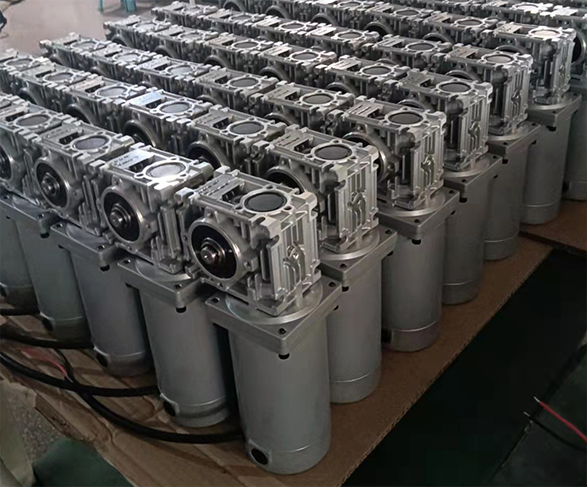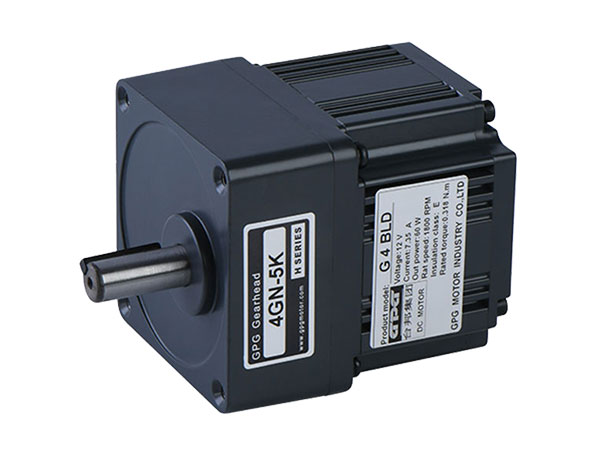- All
- Product Name
- Product Keyword
- Product Model
- Product Summary
- Product Description
- Multi Field Search
Views: 0 Author: Site Editor Publish Time: 2025-03-27 Origin: Site








Do you know the key differences between brushless and regular DC motors? Which one should you choose for your next project? As technology evolves, choosing the right motor for your application becomes more important. Brushless DC motors have gained popularity in fields requiring high precision and efficiency, but traditional DC motors still serve many industries.
In this post, we’ll explore the differences between brushless and regular DC motors. You’ll learn how they work, their advantages and disadvantages, and which motor is better suited for different applications.

A DC motor (Direct Current motor) is a type of electric motor powered by a direct current. In a standard DC motor, electrical energy flows through brushes and a commutator to reach the rotor, causing it to rotate. This simple and cost-effective design makes DC motors ideal for many everyday applications.
In a DC motor, when the current flows through the coils in the rotor, a magnetic field is created, which interacts with the stator's magnetic field to create rotational force. The commutator and brushes are used to reverse the current direction to maintain continuous rotation.
Stator: The stationary part of the motor that creates a magnetic field.
Rotor (Armature): The rotating part that interacts with the stator's magnetic field.
Commutator: A switch that reverses the direction of current in the rotor coils.
Brushes: Conductive materials that provide a connection between the commutator and the power source.
A brushless motor eliminates the need for brushes and a commutator. Instead, it uses an electronic controller to switch the current in the stator coils, creating a magnetic field that interacts with the rotor's permanent magnets. Brushless motors are known for their higher efficiency, longer lifespan, and reduced maintenance needs compared to traditional DC motors.
In a brushless motor, the rotor consists of permanent magnets, and the stator has coils. The motor's controller switches the current in the stator coils, creating a rotating magnetic field that pulls the rotor in sync. This eliminates the need for brushes, reducing wear and tear.
Stator: The stationary part with electromagnets that generate a magnetic field.
Rotor: Permanent magnets that rotate within the stator's magnetic field.
Electronic Controller: Controls the current to the stator and keeps the rotor moving.

Brushless motors are significantly more efficient than DC motors. Since they lack brushes and a commutator, they generate less friction and heat, which results in lower energy loss. In contrast, DC motors suffer from energy losses due to brush friction and wear.
Brushless motors require less maintenance because there are no brushes that wear out. Their lifespan is longer due to fewer mechanical parts that degrade over time.
DC motors require regular maintenance, especially in applications where brushes wear down. The commutator also needs attention due to wear, which can affect motor performance.
DC motors are generally cheaper and simpler to manufacture due to their straightforward design. This makes them ideal for budget-friendly applications.
Brushless motors, on the other hand, have higher initial costs due to the need for a controller and sensors. However, they provide better long-term savings in terms of energy efficiency and durability.
Brushless motors offer superior speed and torque control. The electronic controller enables precise control over the motor’s performance, making them ideal for applications requiring smooth operation and variable speeds.
DC motors have limited speed control and often require additional components like speed controllers or voltage regulators to fine-tune performance.
| Feature | Brushless Motors | DC Motors |
|---|---|---|
| Efficiency | More efficient with less friction and heat. | Less efficient due to brush friction. |
| Maintenance & Lifespan | Lower maintenance, longer lifespan. | Higher maintenance, shorter lifespan. |
| Cost & Complexity | Higher upfront cost, long-term savings. | Cheaper and simpler to manufacture. |
| Speed & Torque Control | Better control with an electronic controller. | Limited control, requires extra components. |
DC motors are ideal for simple, low-cost applications where precision and long lifespan are not as critical. They are commonly used in toys, small appliances, and basic machinery.
Industries such as automotive (e.g., window lifts, wipers) and consumer electronics still rely heavily on DC motors due to their low cost and simplicity.
Brushless motors excel in high-performance applications where efficiency, precision, and longevity are essential. They are commonly used in robotics, drones, electric vehicles, and industrial automation.
Brushless motors are preferred for applications requiring high-speed rotation, low maintenance, and long operational hours.
For low-cost, low-maintenance tasks where precision is less critical, DC motors are a suitable option.
For applications requiring high-efficiency, low maintenance, and precise control, brushless motors are the better choice.
Low cost: DC motors are cheaper to manufacture and maintain.
Simple design: Easy to use and control, especially in low-power applications.
Cost-effective for basic tasks: Perfect for toys, household appliances, and basic automotive systems.
Higher maintenance: Brushes and commutators wear out, requiring frequent maintenance.
Lower efficiency: DC motors are less efficient than brushless motors due to friction and energy loss from brushes.
Shorter lifespan: Wear and tear on brushes and commutators limit the motor's lifespan.
Higher efficiency: Less friction and energy loss, leading to better performance and reduced energy consumption.
Longer lifespan: Fewer moving parts mean less wear and tear, resulting in a longer motor life.
Reduced maintenance: No brushes to replace, reducing maintenance needs and downtime.
Higher cost: More expensive than DC motors due to the need for controllers and sensors.
Complexity: Requires electronic controllers for operation, which can complicate the design and setup.
In conclusion, choosing between a brushless motor and a DC motor depends on your specific needs. DC motors are best for low-cost, simple applications where efficiency and long lifespan are less critical. Brushless motors, while more expensive upfront, offer superior efficiency, reduced maintenance, and longer lifespans, making them ideal for high-performance tasks in fields like robotics and electric vehicles.
For applications that require precision and efficiency, Taibang Motor Industry Group Co., Ltd. offers a range of high-quality brushless motors that provide lasting power with minimal maintenance. Their brushless motors are used in everything from industrial machinery to consumer electronics, helping businesses save energy and boost performance.
A: The main difference is that brushless motors use an electronic controller to manage current without brushes or a commutator, while DC motors rely on brushes and a commutator to deliver current to the rotor.
A: Yes, brushless motors are more efficient due to reduced friction and energy loss, as they don’t have brushes causing wear and tear, unlike DC motors that suffer energy loss from brush friction.
A: Brushless motors require minimal maintenance because they don’t have brushes that wear out. In contrast, DC motors need regular maintenance due to brush wear and commutator issues.
A: DC motors are generally cheaper and simpler to manufacture. However, brushless motors have higher initial costs but offer long-term savings through better efficiency and durability.
We have been back from our holiday.
We will be close from 14th,Jan.to
Airport operators meet more baggage handling challenging these years.We Taibang GPG motor group offers various low noise and reliable TMX113 drum motor to satisfy the airports needs worldwide.If you have need for your airport projects,
Brushless gear motor combines brushless technology and gear systems for better performance, durability, and lower maintenance.
BLDC motors are popular for their efficiency, reliability, and longer lifespan due to their brushless design.
A DC gear motor combines a DC motor and a gearbox to provide precise control, high torque, and reduced speed.
Brushless motors are often considered quieter than brushed motors, making them a popular choice for applications in robotics, drones, and electric vehicles.
Brushless and regular DC motors differ in efficiency, maintenance, and performance, making the right choice crucial for your application.
Gear motors are essential components in various mechanical and electronic systems, combining the functions of an electric motor and a gearbox. The primary purpose of a gear motor is to generate higher torque while maintaining a lower motor output speed, which makes it ideal for applications requirin
AC motors are one of the most popular types of electric motors in the world. They are widely used in industries and homes for various applications. This article will explore the most common type of AC motor and its features, advantages, and disadvantages. AC induction motors AC induction motors ar
Introduction Alternating current (AC) motors are widely used in various industrial and commercial applications due to their efficiency and reliability. However, starting an AC motor can pose challenges, particularly in high-torque applications. Understanding the different starting methods is crucia
A gear motor is a type of electric motor that combines the functions of a motor and a gearbox in a single unit, providing both power and speed reduction or torque multiplication. In contrast, a normal motor—often referred to as a standard or regular motor—does not include a gearbox. It delivers mech
Advantages of AC Gear Motors in Small ApplicationsWhen it comes to powering small applications, AC gear motors have emerged as the go-to solution, offering an impressive combination of power and precision. These micro marvels are revolutionizing various industries, from robotics and medical devices
Small AC gear motors may be small in size, but they pack a powerful punch when it comes to performance and efficiency. In this article, we will explore the advantages of these compact yet mighty devices and delve into their wide range of applications. From improving the precision and control of mach
Variable speed is revolutionizing the world of AC gear motors, unlocking a whole new level of potential and possibilities. With the ability to adjust and control the speed of these motors, businesses and industries are experiencing numerous benefits and finding a wide range of applications. This art
AC drum motors are revolutionizing the way conveyor systems are powered. These innovative motors offer numerous benefits and ensure precise operation, making them the preferred choice for a wide range of industries.One of the key advantages of AC drum motors is their compact design, which eliminates
Hypoid gear motors have become increasingly popular in various industries due to their unique design and exceptional performance. In this article, we will delve into the world of hypoid gear motors and explore their strengths and benefits. Understanding the inner workings of these motors is crucial
Gearboxes play a crucial role in the efficient functioning of mechanical systems across various industries. Whether it's in manufacturing, automotive, or heavy machinery, understanding the intricacies of gearboxes is essential for ensuring optimal performance and longevity. This comprehensive guide
In today's rapidly evolving technological landscape, the efficiency of AC gear motors has become a critical factor in various industries. As businesses strive to improve their operations and reduce energy consumption, the need for highly efficient induction motors has intensified. This article delve
When it comes to automation needs, choosing the right servo motor is crucial. The battle between AC and DC servo motors has been ongoing, and understanding the differences between the two is essential to make an informed decision.